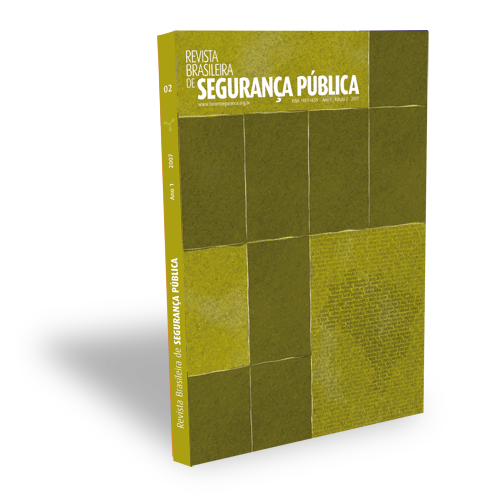Police approach:
a (dis)concerted encounter between the police and the public
DOI:
https://doi.org/10.31060/rbsp.2007.v1.n2.13Keywords:
Police, Police Approach, Use of force, Systematic Social Observation.Abstract
This article explores the relationship between the police and the public during police stops, with the objective of providing more transparency to this encounter, emphasizing the individual conduct of the actors involved.The analysis presented in this study is based on a sample of 90 stops, during two months in 2006, in the city of São Paulo. The data were collected through the technique of Systematic Social Observation, which is a method of direct observation, but not participant. This technique allowed us to observe the policeman performing his policing activities without him knowing that he was being observed.
Downloads
References
ADORNO, S. A criminalidade urbana violenta no Brasil: um recorte temático. BID, Rio de Janeiro, n.35, p.3-24, 1º sem. 1993.
ALPERT, G. P.; DUNHAM, R. G. Analysis of police use-of-force data. U.S., Department of Justice, 2000.
BAYLEY, D. Padrões de policiamento: uma análise internacional comparativa. Trad. de René Alexandre Belmonte. São Paulo: Edusp, 1985 (Série Polícia e Sociedade,1).
BAZLEY, T. D.; LERSCH, K. M.; MIECZKOWSKI, T. Police use of force: detectives in an Urban Police Department. Criminal Justice Review, vol. 31, nº 3, p. 213- 229, 2006.
BITTNER, E. Aspectos do trabalho policial. Trad. Ana Luísa Amêndola Pinheiro. São Paulo: Edusp, 1990 (Série Polícia e Sociedade, 8).
CALDEIRA, T. P. do R. Cidade de muros: crime, segregação e cidadania em São Paulo. Trad. de Frank de Oliveira e Henrique Monteiro. São Paulo: Ed. 34/Edusp, 2000.
CENTRO DE DIREITOS HUMANOS DE SAPOPEMBA – CDHS Cartilha abordagem policial. 2006.
CÓDIGO DE PROCESSO PENAL BRASILEIRO, 1941.
CÓDIGO TRIBUTÁRIO NACIONAL, 1966.
DELORD, R.G.; SANDERS, C.J. et al. Police labormanagement relations: perspectives and practical solutions for implementing change, making reforms, and handling crises for managers and union leaders, vol. I, U. S. Department of Justice, 2006.
INSTITUTO FUTURO BRASIL – IFB. Pesquisa de vitimização na cidade de São Paulo, 2003.
KLINGER, D. Social theory and the street cop: the case of deadly force. Ideas in American Policing. Police Foundation, nº 7, 2005.
MESQUITA, P. Violência policial no Brasil: abordagem teórica e práticas de controle. In: PANDOLFI, D.; CARVALHO. J. M.; CARNEIRO. L. P.; GRYNSZPAN, M. Cidadania, justiça e violência. Rio de Janeiro, Fundação Getúlio Vargas, 1999.
MONET, J. C. Polícias e sociedades na Europa. Trad. de Mary Amazonas Leite de Barros. São Paulo: Edusp, 1986 (Série Polícia e Sociedade, 3).
MUNIZ, J. Ser policial é sobretudo uma razão de ser: cultura e cotidiano da Polícia Militar do Rio de Janeiro. Tese de doutorado. Rio de Janeiro, IUPERJ, 1999.
NATIONAL INSTITUTE OF JUSTICE. Use of force by police: overview of national and local data. Washington, DC: U.S. Department of Justice, Office of Justice Program, 1999.
PINC, T. O uso da força não letal pela polícia nos encontros com o público. Dissertação de Mestrado. São Paulo, Departamento de Ciência Política da Universidade de São Paulo – USP, 2006
PINHEIRO, P. S. Autoritarismo e transição. Revista da USP. São Paulo, USP, n. 9, p. 45-56, 1991.
POLÍCIA MILITAR DO ESTADO DE SÃO PAULO. Manual de tiro defensivo. M-19-PM, 1999.
PINHEIRO, P. S. Guia de procedimentos operacionais padrão, 2002.
PINHEIRO, P. S. Guia de procedimentos operacionais padrão. Revisão dos POP de abordagem policial, 2006.
RAMOS, S.; MUSUMECI, L. Elemento suspeito: abordagem policial e discriminação na cidade do Rio de Janeiro. Rio de Janeiro: Civilização, 2005.
REISS, A. J. (1971). Systematic observation of natural phenomena. Sociological Methodology, vol. 3, p. 3-33, 1971.
TERRILL, W.; REISIG, M. D. Neighborhood context and police use of force. Journal of Research in Crime and Delinqunecy, vol. 40, nº 3, p. 291-321, 2003.
TERRILL, W.; ALPERT, G. P.; DUNHAM, R. G.; SMITH, M. R. (2003). A management tool for evaluating police use of force: an application of the force factor. Police Quartely, vol. 6, nº 2, p. 150-171, 2003.
WEIDNER, R. R.; TERRILL, W. A test of turk’s theory of norm resistance using observational data on police suspect encounters.Journal of Research in Crime and Delinquency, vol. 42, n. 1, p. 84-109, 2005.
ZALUAR, A. Condomínio do diabo.Rio de Janeiro: Ed. UFRJ, 1994.
Downloads
Published
How to Cite
Issue
Section
License
Copyright (c) 2012 Revista Brasileira de Segurança Pública

This work is licensed under a Creative Commons Attribution 4.0 International License.
Licensing
The Brazilian Journal of Public Security uses the Creative Commons License as a form of licensing for its published works. The license used follows the CC BY 4.0 - Attribution 4.0 International model.
To see the permitted rights please go to the full licence or to our Copyright and Licensing page.



